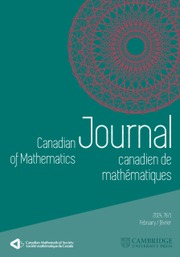No CrossRef data available.
Article contents
2-Elongated plane partitions and powers of 7: the localization method applied to a genus 1 congruence family
Published online by Cambridge University Press: 22 August 2025
Abstract
Over the last century, a large variety of infinite congruence families have been discovered and studied, exhibiting a great variety with respect to their difficulty. Major complicating factors arise from the topology of the associated modular curve: classical techniques are sufficient when the associated curve has cusp count 2 and genus 0. Recent work has led to new techniques that have proven useful when the associated curve has cusp count greater than 2 and genus 0. We show here that these techniques may be adapted in the case of positive genus. In particular, we examine a congruence family over the 2-elongated plane partition diamond counting function  $d_2(n)$ by powers of 7, for which the associated modular curve has cusp count 4 and genus 1. We compare our method with other techniques for proving genus 1 congruence families, and conjecture a second congruence family by powers of 7, which may be amenable to similar techniques.
$d_2(n)$ by powers of 7, for which the associated modular curve has cusp count 4 and genus 1. We compare our method with other techniques for proving genus 1 congruence families, and conjecture a second congruence family by powers of 7, which may be amenable to similar techniques.
MSC classification
Information
- Type
- Article
- Information
- Copyright
- © The Author(s), 2025. Published by Cambridge University Press on behalf of Canadian Mathematical Society


